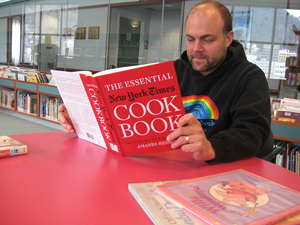
Source: Can you guess where?, MERealtah, Flickr
Advertisements often use parallel sentences. Consider this magazine advertisement for L.L. Bean, a mail-order company in Maine that sells and ships clothing and gear for outdoor activities.
The adventure is on you.
The sentences are perfectly parallel.
| Subject | Verb | Prepositional phrase |
|---|---|---|
| The shipping | is | on us |
| The adventure | is | on you |
Parallel sentences can make writing much more attention-grabbing—and also clearer and easier to follow. Trying to follow instructions that do not contain parallel sentences shows how helpful parallel sentences can be. For example, read two versions of instructions for a simple task: using a mail-order catalog.
Nonparallel instructions
1. Open the catalog first.
2. You must read the text now.
3. Looking at the pictures, peruse.
4. What you like should be circled.
Revised, parallel instructions
1. Open the catalog.
2. Read the text.
3. View the pictures.
4. Circle the items you like.
Imagine using a mail-order catalog for the very first time. Which set of steps would be easier to follow?
The writer made only a few simple changes to straighten out these sentences. The changes are as follows:
- There’s no need for “first” in #1 since that direction is listed first. Removing that extra word makes it easier to line it up with other steps.
- Also, the writer moved the verb of #2, “read,” to the beginning of the sentence, which is where the verb is in #1.
- By revising steps 3 and 4 similarly, the writer has made all the sentences grammatically identical.

Source: Self-Portrait with Book, Alaska Library Association, Flickr
If you have ever followed a recipe, you have encountered imperative sentences that are parallel as well. By imperative we mean sentences that command with an understood 'you' at the beginning of each sentence. Instructions should always be provided in imperative sentences. The balance of the sentences make it possible for you to concentrate on the steps involved so that you can succeed at the task. Look at the difference between the parallel and nonparallel recipes below.
Nonparallel recipe
- Cut cooked chicken into thin slices.
- You must now place them in a bowl and you should sprinkle them with salt and pepper.
- You’ll need some yogurt, which you should mix together with cucumber in a small bowl.
- Split the pitas into pockets.
- Go back to the yogurt and cucumber you mixed together. Spread 2 tablespoons of it in each pita.
- You’ll need ¼ of the chicken slices for each pocket, which you will then close up, wrap in plastic wrap, chill in the refrigerator overnight. Then, you’ll cut them in half to serve.
Parallel recipe
- Cut chicken into thin slices and place in bowl.
- Sprinkle slices with salt and pepper.
- Mix yogurt and cucumber together in a small bowl.
- Split the pitas into pockets.
- Spread 2 tablespoons of yogurt-cucumber mixture into each pita.
- Place ¼ of the chicken slices in each pocket, wrap in plastic, and chill in the refrigerator overnight.
- Cut pockets in half to serve.
The parallel recipe consists of seven parallel sentences that give advice. Each sentence begins with a verb (cut, sprinkle, mix, split, spread, place, cut) that clearly guides you through the steps in the preparation of the dish. The sentences in the nonparallel recipe are confusing. Some begin with a subject (you) and some with a verb (cut, split, go back). The parallel recipe is much easier to follow.
See if you can identify the parallelism in this three-sentence online advertisement for Sprint.

Source: Sprint: Power Up, ninja M, Flickr
Watch what you love with a 4.7” HD Display.
Hear what you love with an authentic Beats Audio™ experience.
Capture what you love with simultaneous video and still shooting.
Note the pattern that is repeated in each sentence.
| Verb | Object of the verb repeated | Prepositional phrase |
|---|---|---|
| Watch | what you love | with a 4.7” HD Display. |
| Hear | what you love | with an authentic Beats Audio™ experience. |
| Capture | what you love | with simultaneous video and still shooting. |
Let’s look at the example below.

Source: Wgretz edit2, Hakandahlstrom, Wikimedia
A good hockey player plays where the puck is. A great hockey player plays where the puck is going to be.
